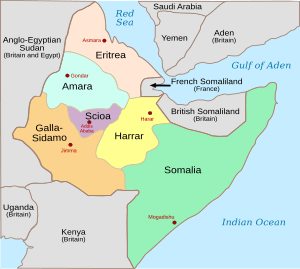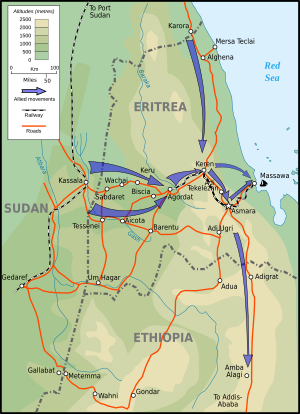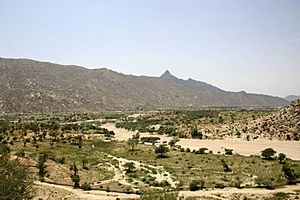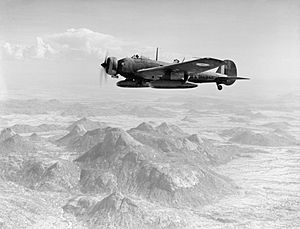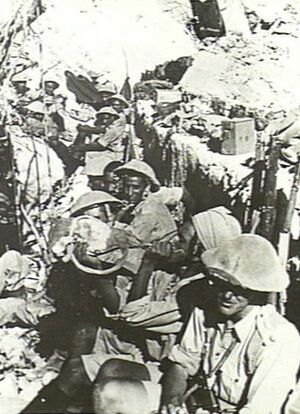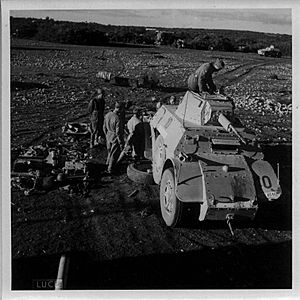Battle of Keren facts for kids
Quick facts for kids Battle of Keren |
|||||||
|---|---|---|---|---|---|---|---|
| Part of the East African Campaign of the Second World War | |||||||
 Indian troops at Keren (Cheren), May 1941 |
|||||||
|
|||||||
| Belligerents | |||||||
|
|
|
||||||
| Commanders and leaders | |||||||
|
|
||||||
| Units involved | |||||||
|
|
||||||
| Strength | |||||||
| 13,000 | 23,000 | ||||||
| Casualties and losses | |||||||
|
|
||||||
The Battle of Keren was a major fight during the Second World War. It happened in Eritrea, a country in East Africa, from February 3 to March 27, 1941. British and Free French forces attacked the town of Keren, which was held by Italian troops. Keren was very important because the main road and railway to Asmara, the capital, and Massawa, a port on the Red Sea, passed through it. Taking Keren would help the Allies control this part of Africa.
Background to the Battle
Eritrea's History
Eritrea was an Italian colony since 1885. Italy used it as a base to invade Ethiopia twice. After the second invasion in 1935, Italy combined Eritrea, Ethiopia, and Italian Somaliland to form Italian East Africa. When Italy joined the war in 1940, its leader, Benito Mussolini, ordered his troops to capture British areas nearby.
British Forces Prepare
The British prepared for war by gathering many soldiers in Sudan and Kenya. By early 1941, Lieutenant-General William Platt led the British forces from Sudan. They invaded Eritrea on January 18 and captured Agordat, a town about 100 kilometers (60 miles) east of Keren, by February 1.
Italian Moves in Sudan
In July 1940, Italian troops from Eritrea invaded Anglo-Egyptian Sudan. They captured a railway town called Kassala. The Italians fortified Kassala, but they didn't go much further into Sudan. This set the stage for the British counter-attack into Eritrea.
Preparing for the Fight
Keren's Strong Defenses
Keren was not a traditional fort, but it was naturally very strong. It was surrounded by steep mountains and sharp ridges. These high points gave the Italian defenders a huge advantage. They could see any attack coming and direct their artillery fire perfectly.
The main road and railway to Keren passed through a narrow place called the Dongolaas Gorge. This gorge was guarded by high mountains like Mount Zeban and Mount Falestoh, which had a strong fort called Fort Dologorodoc. On the other side of the gorge was Mount Sanchil, with other peaks like Brig's Peak and Flat Top. These mountains made Keren a very tough place to attack.
British and Indian Troops Advance
The British sent the 5th Indian Infantry Division to Sudan in late 1940. They formed a fast-moving unit called Gazelle Force to raid Italian areas. By January 30, Gazelle Force was chasing the retreating Italian army towards Keren.
As the British got closer, Italian General Nicolangelo Carnimeo brought in more troops to defend Keren. Soldiers from different Italian units, including the Savoia Grenadiers, arrived after long journeys. Keren was ready for a big battle.
The Battle Begins
Early Attacks (February 5-8)
On February 1, Gazelle Force was stopped by a blown-up bridge and mines near Keren. The Italians had also blocked the Dongolaas Gorge with huge rocks.
On February 5, the 11th Indian Infantry Brigade attacked the left side of the gorge. The 2nd Queen's Own Cameron Highlanders fought hard to reach a ridge called feature 1616. Indian troops then pushed onto Brig's Peak. But the Italian Savoia Grenadiers fought back fiercely, forcing them to retreat to Cameron Ridge. The British and Indian soldiers held on despite many attacks and the difficulty of bringing supplies up the steep hills.
On February 7, the 5th Indian Infantry Brigade attacked the Dologorodoc area on the east side of the gorge. They tried to attack from the south-east. A company of the 4th Battalion/6th Rajputana Rifles managed to take a key pass, but they ran out of ammunition and had to pull back.
More Fighting (February 10-13)
On February 10, the 3rd Battalion/1st Punjab Regiment attacked Brig's Peak and reached Sanchil the next morning. However, they had too few soldiers to hold the position and were forced off by a strong Italian counter-attack.
The 29th Indian Infantry Brigade was brought in to help. On February 12, the 4th Battalion/6th Rajputana Rifles attacked again. A brave soldier named Richhpal Ram was badly wounded but kept fighting. He was later given the Victoria Cross, a very high award, for his courage.
After these tough fights, the British commander, Platt, decided to pause. He needed to regroup his forces and bring up more supplies. The 5th Indian Infantry Division went back to Kassala for training.
New Attack Plan
The British planned a new, big attack. Major-General Noel Beresford-Peirse's 4th Indian Infantry Division would attack the Sanchil mountains. Major-General Lewis Heath's 5th Indian Infantry Division would attack the Dologorodoc side. The Italians had also brought in more troops, so there were about 25,000 defenders against 13,000 attackers.
Heath decided that Fort Dologorodoc was the most important target for his division. Capturing it would allow the British to direct artillery fire on both sides of the gorge. The attacks were planned for March 15. Platt told his commanders that it would be a "bloody battle" but that they would win.
Final Push (March 15-27)
On March 15, the 4th Indian Infantry Division attacked Sanchil. The fighting was very intense, with heavy losses on both sides. On the right, the 5th Indian Infantry Division attacked Dologorodoc. The 2nd Highland Light Infantry tried to attack but were stopped by Italian fire.
That night, the 9th Brigade, led by Brigadier Messervy, attacked again. The 3rd Battalion/5th Mahratta Light Infantry, led by Lieutenant-Colonel Denys Reid, captured a key position called Pinnacle. This was a very difficult and important achievement.
In the early hours of March 16, the Italians counter-attacked Pinnacle. But the 2nd West Yorkshire Regiment managed to surprise the defenders of Fort Dologorodoc and captured it by 6:30 AM. This was a huge victory, giving the British a vital observation point for their artillery.
For the next ten days, the Italians tried hard to take back Fort Dologorodoc, but they failed. The 4th Indian Division continued to fight on the Sanchil side, but they suffered many casualties and had to pull back from some areas.
Platt decided the main attack should go through the Dongolaas Gorge itself. Engineers worked to clear the road block, but Italian fire made it difficult. Heath realized that two smaller hills, the Railway Bumps, overlooking the roadblock were key.
On March 24, the British made diversionary attacks. The West Yorkshires and the 3rd Battalion/5th Mahrattas moved down from Fort Dologorodoc to take the lower hills overlooking the gorge. They succeeded, silencing the Italian defenses on that side.
At 3:00 AM on March 25, the 2nd Highland Light Infantry and 4th Battalion/10th Baluch Regiment advanced into the gorge. With heavy artillery fire on Sanchil, the attack surprised the Italians. By 5:30 AM, the Railway Bumps were captured, and the Italians could no longer fire into the gorge.
Engineers worked hard to clear the road. By midday on March 26, the road through the gorge was open. In the early hours of March 27, the British attacked Mount Zeban and Mount Canabai. They found the Italians had withdrawn, and they took these positions without a fight. The Italian position was hopeless. The Royal Air Force (RAF) reported the Italians retreating towards Asmara. The Italian soldiers on Sanchil were cut off and had to surrender. British forces entered Keren by 10:30 AM and chased the retreating Italians.
Aftermath
Casualties
The battle was very costly for both sides. British and Commonwealth forces had about 536 killed and 3,229 wounded. Italian and Eritrean troops suffered much higher losses, with estimates of 3,000 Italian soldiers killed, 4,500 wounded, and around 9,000 Eritrean soldiers killed.
Massawa Falls
After Keren, the British moved towards Massawa, a port city. The Italian commander, Rear-Admiral Mario Bonetti, had 10,000 troops and about 100 tanks. He refused to surrender. On April 2, the last Italian destroyers left Massawa to attack Port Sudan before sinking themselves.
On April 8, the British attacked Massawa. The 10th Indian Infantry Brigade and tanks broke through the defenses. Free French forces also attacked, capturing key positions. Colonel Monclar of the 13th French Foreign Legion Demi-Brigade captured the Italian Admiralty building and accepted Bonetti's surrender. The British took 9,590 prisoners and 127 guns.
The Italians had tried to block the harbor by sinking many ships and equipment. But the British worked quickly to clear it. By May 1, the port was open and could be used to supply British forces. The fall of Massawa ended organized Italian resistance in Eritrea. This victory was important because it removed the threat to shipping in the Red Sea.
See also
- List of British military equipment of World War II
- List of French military equipment of World War II
- List of Italian Army equipment in World War II
- Order of Battle, East African Campaign (World War II)


